






It will be an instant Tāmaki Makaurau landmark , a seven-storey sentinel of vibrant, verdant green, the colour of fresh harakeke (flax). Subtle shifts of glaze — and a shimmering fine grain pattern — will adorn its brick walls, a look inspired by the triangular tukutuku panels of Hotunui, the great Ngāti Maru wharenui that lives at Auckland Museum.

The eighth partnership between award-winning developers Ockham Residential and Marutūāhu Iwi, Toi is unmistakeably of Aotearoa. The name means art or knowledge in te reo rangatira, but additional — and resonant — layers of meaning can be found within our native language. Toi also means point, summit, indigenous or origin — associations that are amply evident within this beautiful whare.
Geographically blessed, Toi sits 400m from Pt Chev Village, home to one of the busiest bus routes in the city and, very possibly, its finest bread — the warm, golden sourdough deliciousness of Daily Bread. It’s less than a kilometre from the eclectic buzz of Mt Albert Shops with its hilariously duelling BBQ noodle houses. It’s a short walk from the Mt Albert and Baldwin Ave train stations, while the Northwestern bike path zooms by your door, the city a 10-minute ride away.
Here lies the best backyard in the city. Stroll down Pt Chev Road, past a French-inspired café cluster, past Pt Chev Beach Café with its heavenly gelato, and cool off at Auckland’s gentlest, dreamiest family beach. Collect your thoughts with a wander around Western Springs or head straight to the tranquil inner-city wilderness of Te Auaunga / Oakley Creek with its mesmeric six-metre waterfall.
In the heart of the isthmus, right among the action, this is simply a wonderful place to live. We also think it’s a more thoughtful way of living — connected, community-centred and much less carbon-intensive. For life’s too short to languish in urban sprawl miles away, only to chug back in along choked motorways.
With 65 apartments in a range of studios, one, two and three bedroom options, as well as a residents’ lounge, Toi is your ticket to an exciting new lifestyle. But there’s something extra-special about this one. Toi is the first building, the foundation stone of a new suburb, an entirely new community called Maungārongo. Read on!
A new community is coming. Over the next two decades, the Te Auaunga Precinct — 40 hectares of land running from the old Carrington Hospital up to Unitec — will be developed by the three Auckland rōpū (iwi collective groups): Marutūāhu, Te Waiohua and Ngāti Whātua. “It is the most precious development area in the city,” says Marutūāhu chair, Paul Majurey. “The biggest brownfield redevelopment in Auckland.”
Through the Ngā Mana Whenua o Tāmaki Makaurau Collective Treaty settlement of 2014, each rōpū will masterplan and develop their respective areas — Marutūāhu in the north, Te Waiohua in the centre and Ngāti Whātua in the south.
“Our allocation is over 10 hectares, beginning near Pt Chev Village and continuing for 400m along Carrington Road towards Mt Albert,” Majurey says.
Marutūāhu have given it the name Maungārongo. “There are layers to its meaning of peace,” Majurey says, “from a space of calmness and harmony, to an absence of stress and tension. Maungārongo is also an etymological nod to the famous Tūpuna Maunga of Tāmaki Makaurau.”
“It’s a staged development, a 10-15-year project. In time, it will have over 3,000 homes across 40 buildings. It’s a village within a city — an urban kāinga of self-sufficient communities which animates Auckland’s ambition to be a compact and connected city.”
PAUL MAJUREY, MARUTŪĀHUToi is the first building in an initial tranche of four that’ll be built along the north-east edge of Maungārongo, down the Pt Chev end, near the historic brick buildings of the former Carrington Hospital.
“Maungārongo is a staged development, a 10-to-15-year project,” Majurey continues. “In time, it will have over 3,000 homes across 40 buildings. It’s a village within a city — an urban kāinga of self-sufficient communities which animates Auckland’s ambition to be a compact and connected city.”
The masterplan hints at what’s to come — think a metro supermarket, medical centre, creche, 24-hour gym, swimming pool, cafes, restaurants, commercial spaces, co-working offices, playgrounds, recreational spaces, community gardens and more.
Creating a community from scratch is a fusion of creativity and coherence. “The buildings will be arranged around an array of community spaces where people can mix and mingle,” Majurey explains. “Everything will be walkable and accessible; foot traffic and biking is prioritised. There will be little internal car traffic.”
This future-proofed community carefully connects with the past. “There will be a harmony, a connection with the whenua,” Majurey says. “A union that reflects the holistic knowledge of Tāmaki Makaurau gleaned from centuries of living here.”
Ockham captain, Mark Todd echoes the big-picture vision. “A key value we share with Marutūāhu is that we want to steward the whenua (land) across generations,” he says. “We want to build homes that people will be proud to live in across generations too.”
While Maungārongo is a hugely ambitious project, masterplanned over thousands of hours, Todd says it’s important it has space to evolve. He likens it to a painting.

Maungārongo celebrates the remarkable natural and cultural landscapes of Tāmaki Makaurau. Mātauranga Māori — a Māori worldview — will be at its heart, realised in the living spaces, shared community areas, native plantings, the streetscapes and trees that line them and, not least, in the buildings themselves.
Our design approach will incorporate Te Ao Māori in an authentic and thrillingly contemporary way. We’ve already shown how it can be done.
Each day, tens of thousands of Aucklanders pass along Waterview’s Great North Road — and bear witness to the stunning Māori design elements of Kōkihi: pou, waharoa and precast concrete patterning.
Though newly built, these precast panels convey a deep history: their motifs reference the tukutuku panels of Hotunui, the great Ngāti Maru/Marutūāhu wharenui at Auckland Museum. Geometric designs allude to Niho Taniwha — the teeth of the taniwha — and Kaokao — the warrior in action. Depending on light and sun and season, they change colour between gun-metal grey and glimmering silver. They’re spectacular, especially after rain when they gleam.
“We’re bringing a millennia of experience to Maungārongo,” says Paul Majurey. “We’re weaving our ancestral knowledge in with the kaupapa of ‘Ngāti Ockham’. The detail — from the patterning of the brick to the arrangement of the pavers; from the landscaping and extensive native planting, to the positioning of the waharoa (gateways) in reference to the Tūpuna Maunga — will all be informed by Mātauranga Māori.
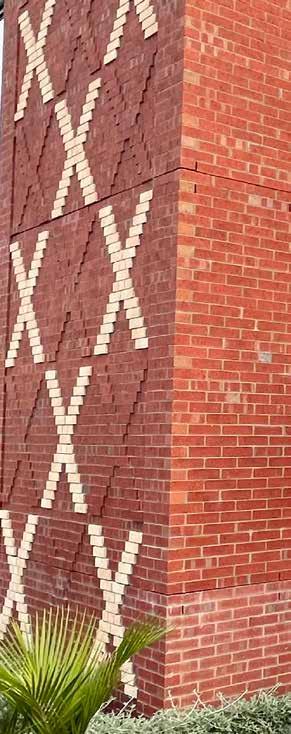
“The colour schemes are going to be very different, reflecting different parts of nature, different reference points from our precious wharenui, Hotunui, the location of the patterns, the types of fabric and weave. And it’s very, very exciting.”
“We have a firm ambition for Maungārongo,” says Ockham’s Mark Todd. “It will have a distinctly Māori design vernacular and South Pacific flavour.
“The buildings will be between mostly six and 10 storeys across the development. Of course, the shapes and geometry of high-density housing are quite similar the world over. But what will be different — notably if you approach the buildings as a pedestrian or a cyclist — is you’ll see a definite Māori design aesthetic woven into the things that you touch, the door handles, entrances, the landscaping, the brick facades themselves. It’ll draw you in, be irresistible to explore.
“You won’t be confused about where you are in the world: you are in Aotearoa, the South Pacific. And the small human details will reflect that.”
“We’re bringing a millennia of experience to Maungārongo. Weaving our knowledge with the kaupapa of ‘Ngāti Ockham’. The detail — from the patterning of the brick, to the extensive native planting… to the positioning of the waharoa in reference to the Tūpuna Maunga — will be informed by Mātauranga Māori.”
 PAUL MAJUREY, MARUTŪĀHU
PAUL MAJUREY, MARUTŪĀHU
Mātauranga Māori is at the heart of Maungārongo. The Marutūāhu | Ockham passion for diversity of people and ideas also accesses inspiration from abroad. “We’re taking our cues from international cities,” says Ockham’s Mark Todd. “This will be a high-density community. But the density is balanced by an extensive network of green spaces, interconnected and woven around the buildings.

Density done deftly gives land back to the people. “The corollary of apartment living is that you’re not hemmed in to your own small fiefdom,” Todd argues. “High density gives you space to experience a wider world. The city becomes your backyard.”
High density urban planning is the norm and very successful in old Europe, Todd says. “That’s what we aspire to with Maungārongo.”
“Maungarōngo will show what’s possible. Creativity and imagination are at the heart of transformational projects. And we want to be light-hearted and forward-thinking in our approach. We want to retain humility – and so we ’ ll bring some humour, bring some colour. Auckland is one of the most cosmopolitan multicultural cities on earth. It’s definitely the cultural centre of the South Pacific. And we want to reflect that vibrance.”
MARK TODD, OCKHAMThe Marutūāhu | Ockham shared kaupapa is informed by core principles:
A REVERENCE FOR LAND AND PLACE A deep connection to Tāmaki Makaurau, one of the world’s loveliest cities and a wonderful place to live. We will enhance our small part of it with extensive native planting.
A UNIQUELY AOTEAROAN FLAVOUR. By articulating an expression of the Māori worldview, our buildings are immediately recognisable as being of Tāmaki Makaurau.
A LONG-TERM OUTLOOK. We see housing as infrastructure, a legacy we leave to future generations. We want our developments to be beautiful, loved and crafted from durable, lowmaintenance materials that age gracefully.
A SUSTAINABLE FUTURE. Green initiatives will give the community resilience and options to evolve — green infrastructure, creating local circular economies, reintroducing native flora, enhancing biodiversity, constructing low-maintenance healthy homes, and establishing community gardens.
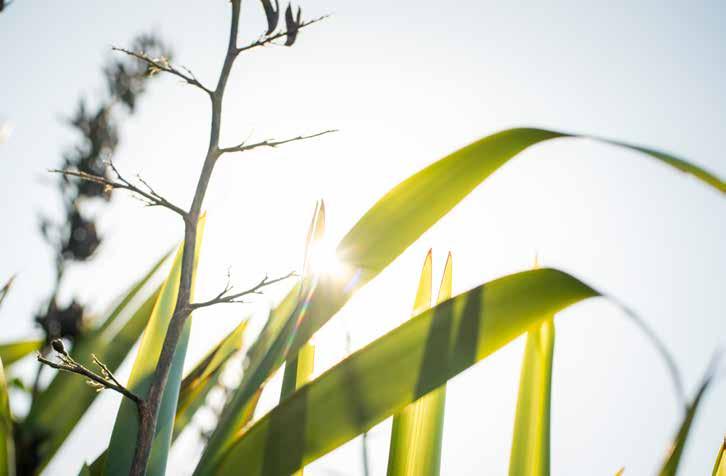
CONNECTION OF WHĀNAU TO WHENUA. We will prioritise people over cars. An interconnected network of paths, streets and laneways will enable people to move through Maungārongo intuitively and joyfully: our goal is to create a village that’s easy to get about in for people of all ages and stages.
A COMMITMENT TO COMMUNITY. Establish inclusive and self-sufficient communities that encourage cohesion between people and place. Emphasise shared spaces for people to meet, talk, work and play.
A CITY FOR ALL. Maungārongo will be a village for young and old, for families and for those living by themselves. There will be an affordable housing component — a city that looks after everyone is better for us all.
Enter Auckland War Memorial Museum , step inside its Grand Foyer with its spectacular stained glass leadlight ceiling, and directly ahead, the museum’s centrepiece, stands Hotunui, wharenui (meeting house) of Ngāti Maru and Marutūāhu.
As a one-two punch, these two buildings are unsurpassed in our city — and the pilgrimage across Pukekawa (Auckland Domain) from Ockham’s Grafton HQ is a welcome (and well-worn) one. This is where our architectural designers, sketch pads and charcoal pencils in hand, often come for inspiration.
Toi architectural designer, Hannah Chiaroni-Clarke, says past Marutūāhu | Ockham projects have skilfully incorporated Hotunui motifs. “The brick patterning at Tuatahi and Kōkihi references the tukutuku panels at Hotunui. But Toi — in so many ways — will be different again.”
Inspiration can come quickly. “The first thing that caught my attention at Hotunui is how much the tututuku panels change from far away to up close.
“They’re a very fine grain pattern up close, a collection of crosses really, but as you step away they change into something else entirely.”
Recognising the patterning would translate beautifully to the partners’ signature brick facades, Chiaroni-Clarke worked with Marutūāhu artists to incorporate triangular tukutuku woven patterns into the façade. “With the use of different coloured glazed bricks a fine grain pattern weaves its way across the facades. Like the tukutuku panel, the patterning plays with scale, providing intricate detailing up close, a broader pattern from afar.”
A beguiling mix of order and abstraction informs the first four buildings at Maungārongo. “The block hierarchy and colour selection is inspired by the harakeke — and is another elemental nod to the tukutuku of Hotunui,” Chiaroni-Clarke says.
“The four stages of growth of the harakeke are applied to these four buildings — and instruct the sequence of the build.”
Toi, the first building to be built, reflects the first stage — rito (the young centre shoot). Verdant light green symbolises the beginning.
Alongside Toi, the next building, the tallest of the four, will echo the kakau and korari, the stalk and flower stem of the harakeke. Coloured dark purple and red, this will be the one you will see from afar.
The third building will reflect the awhi rito, the parent — the deep, rich green leaves that stand tall to surround and cosset the rito.
Fourth, and outside the awhi rito, are the tūpuna or older leaves — the silvery green strips used for weaving. Symbolising stability and permanence, this will be the last building built in the block.
“This project is our contribution to an Aotearoa aesthetic,” Chiaroni-Clarke continues. “A re-imagining of what Aotearoa multi-density housing can look like.”
It also represents a continuation of Marutūāhu | Ockham craft and partnership. “It has been a privilege to collaborate with Marutūāhu artists to design these iconic features,” ChiaroniClarke says.
“We’ve endeavoured to bring a Te Ao Māori worldview to Toi. From the roof lines to the walls; from the waharoa to the door handles the residents use to enter their buildings, design concepts have been developed with Marutūāhu and their artists to create a unique and distinctly Aotearoan experience throughout.”
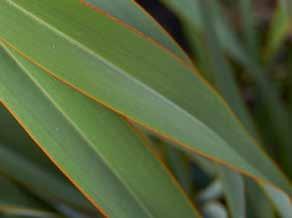
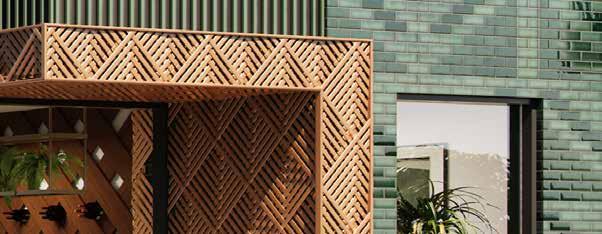



Our buildings will last for generations because we use classic, proven materials we know will stand the test of time. Instantly recognisable, Toi is a striking refinement of the distinctly residential ‘look’ that has evolved over Ockham’s 21 developments so far.

Its walls are warmly, solidly brick — a custom-coloured, verdant green inspired by the harakeke. It looks fabulous — style and substance we like to think — though there’s more to this than mere aesthetics. Says Ockham’s Mark Todd: “It’s an essential design principle we follow: we want our buildings to age gracefully with minimal ongoing costs. I believe developers have an ethical obligation to build with durable materials so residents are spared unnecessary maintenance work.”
• Built to the latest engineering and earthquake standards.
• Foundations: concrete slab on concrete ground beams and piles.
• Exterior walls of precast concrete or timber-framed walls within a brick facade. Both durable and beautiful.
• Timber-decked balconies atop concrete bases (with powder-coated aluminium balustrades).
• Highly efficient hot water system provides unlimited, individually metered hot water.
• Double-glazed windows keep heat in and noise out.
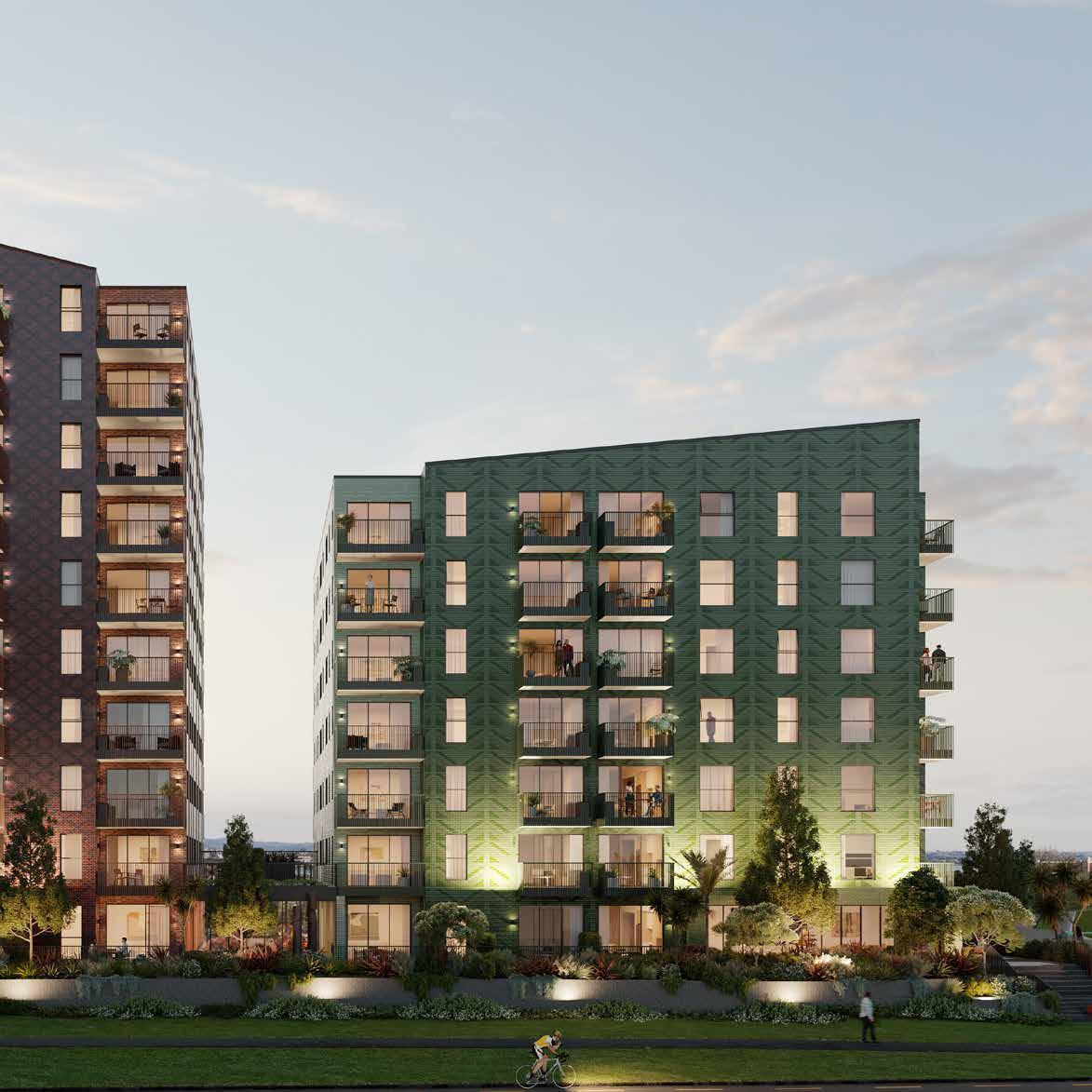
Your home – your domain, your whare, your palace! — is the centre of your private life, a space to reflect, rest and revive. It’s a place where the clamour of the outside world is kept at bay — perhaps contemplated on from the outlook of a sheltered balcony or window. The interiors of Toi have been designed with the principles of living well, creating a feeling of deep self-accord. Optimised for light, privacy and easy urban living but intimate too, with options that are flexible to your personal taste.
“My apartment is so well designed and I can’t tell you how warm it is!
We’re into July now and I haven’t had to use the heat pump at all.”

ELLY RICHARDS (KŌKIHI OWNER)
• High stud ceilings: studs are generally 2.6m.
• Over-height internal doors: 2.2m.
• Common area corridors are a generous width.
• LED lighting: energy-efficient and long-lasting.
• Loop pile solution-dyed nylon carpet. Stylish and hard-wearing.
• Intelligent storage design (quality wardrobe organisers etc) maximises space.
• Heat pumps in every apartment. Additional fresh-air ventilation.
• Fitted for fibre.
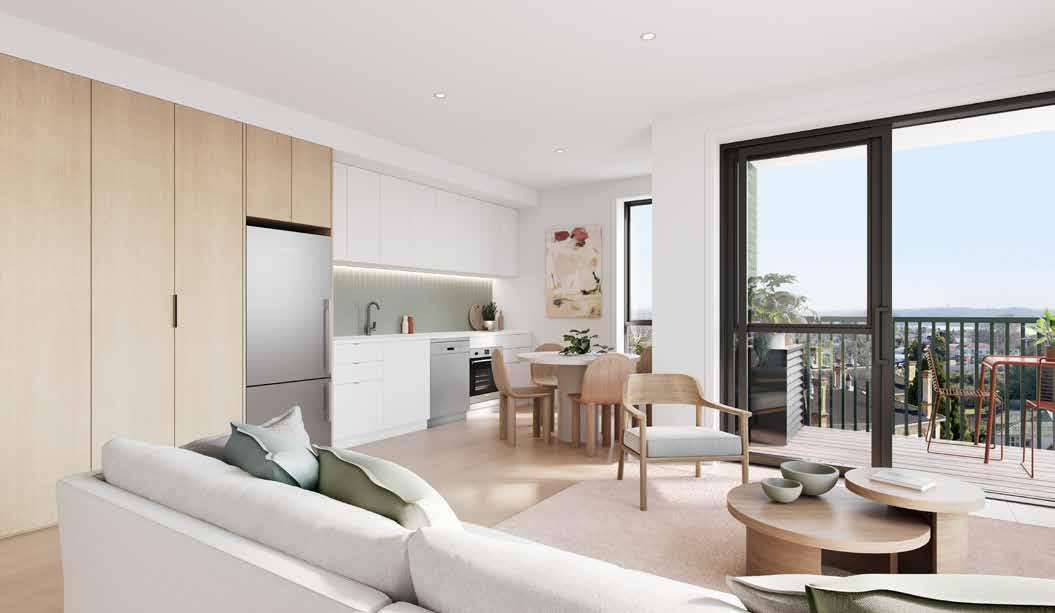
“We love that our apartment is basically maintenance-free. We’ve got our little deck where we’ve set up the barbecue and got a few chairs and things... that’s enough for us. Having a space that requires a lot less work is great as we both have quite busy lifestyles.”
JOSH DALY (KŌKIHI OWNER)
We take our kitchens very seriously. Not only are they the most utilitarian parts of your home (and often a secondary social hub), they need to look good too. For Toi we’ve chosen a herringbone mosaic for the kitchen splashbacks, echoing hints of the woven flax-like brick patterning outside.
• Quality New Zealand-made kitchens with soft-close drawers. Chic and practical.
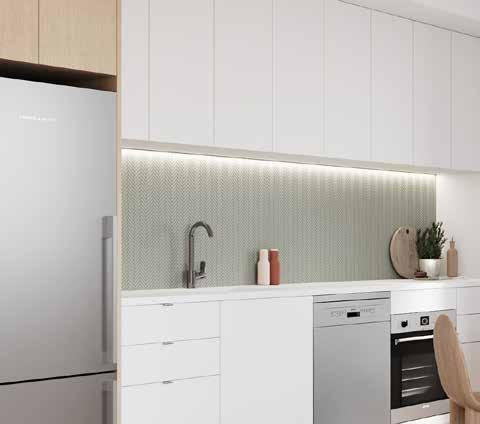
• Engineered stone benchtops — easy to clean and super-durable.
• Mosaic tiled splashbacks (with feature LED strip light).
• Appliance package includes oven, induction cooktop, rangehood, dishwasher and condenser washer/dryer.
• Choice of white or light-green palettes.

The woven pattern continues in the bathroom with a chevron tile. The vanity can either be in a neutral timber or a light green if you’re keen for a pop of colour.
• Porcelain tiles on bathroom floor and shower wall. Looks exquisite and is easy to clean.

• New Zealand-made vanities and cabinet. Quality local fare.
• Heated towel rails keep your towels toasty.
• Frameless glass shower screens with customised, stainless steel New Zealand-made shower bases.
• Choice of timber-look or green palettes.

Buying an apartment off the plans is different to buying an existing house. It’s an ongoing relationship that requires trust on your part — in return for transparency, candour and consistent updates from us. And doing what we say we will.
We have a track record of delivery through 14 completed developments so far. We keep our word. That’s why half the apartments we sell are to people who’ve either bought from us before, or been referred to us by existing Ockham owners.
If you’d like to buy at Toi — if every page of this understated brochure has you metaphorically measuring the drapes — then this is what you need to know.
1. Very important — it’s essential you do your own research. No matter how keen you are, you should talk to a lawyer and a mortgage advisor / bank before you commit to anything.
2. Once you have the green light, come see us. We’ll draw up a Sale & Purchase Agreement for you to sign. We’ll take you through this step-by-step and answer any questions you may have.
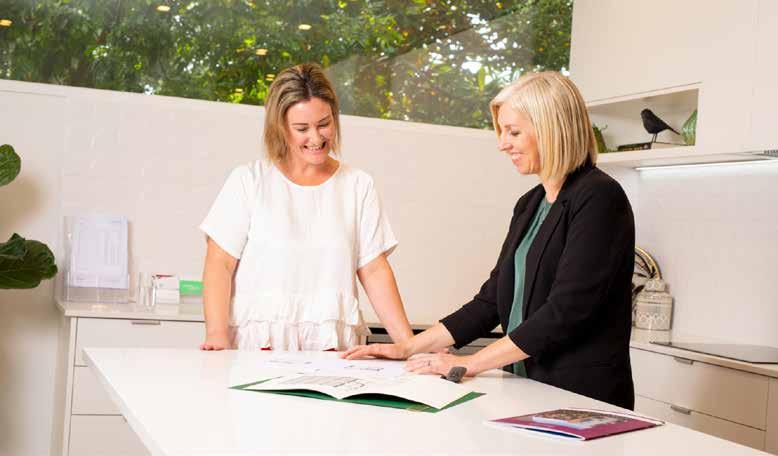
3. Due diligence: We include a 10 working-day ‘due diligence’ condition. This is an opportunity for you to do your homework, get your finances sorted, and for your lawyer to cross the t’s and dot the i’s. You can walk away from your conditional purchase during this time if you decide Toi is not the right home for you. A ‘safety-net’ of sorts.
4. Happy to lock it in? Your lawyer will satisfy the due diligence and any other conditions — and you’ll pay a 10% deposit. It’s important to note that deposits are held securely in trust by Ockham Residential’s lawyer until settlement — they cannot be used to finance the development.
5. Since we design, consent, construct (and sell) our apartments in-house , we’re across every aspect of the build. From the day you sign up until the day you move in, we’ll send you regular updates, pics and work-in-progress videos in the Toi Owners’ Circle newsletter.
6. Settlement: Your lawyer makes the magic happen — the balance is paid and settlement ensues. We’ll meet you and hand over the treasured keys to your new apartment (and perhaps some surprise treats). Congratulations!
Perfectly positioned in the centre of the isthmus, Pt Chev enjoys the relaxed vibe that comes from being on the edge of the city, yet somehow standing apart. Within walking distance of Toi, you’ll find Auckland’s most tranquil lake, its tallest waterfall, its calmest, most zen beach. It’s also home to the country’s leading zoo, its finest bakery and (we say) best top-secret neighbourhood bar. Meet some of the locals…
DAILY BREAD Occupying the grand, neoclassical ASB building, the award-winning Daily Bread enjoys a following of biblical proportions. Since opening in 2018, they’ve added five more stores around the city, though Pt Chev remains the mothership. Each day, 800 of their signature sourdough loaves are baked here — up to 1,200 on weekends — and then delivered around Tāmaki Makaurau.
Their simplest loaf, the pioneer sourdough, remains the most popular. The secret? Baker Rhys Harvey explains. “Our bread is epic. The sourdough starter we use is 600 years old.”
It’s the inheritance of Daily Bread’s head baker, Patrick Welzenbach. “His family have manned the oven in his home village in Germany since then and still do today,” Rhys says. “Twenty-two generations have been looking after the starter.”
There are other mystical elements: Welzenbach brought 15th century cast-iron cutters with him when he came out to New Zealand, along with some semi-secret family recipes. Because, Rhys explains, there’s art and more than a little magic involved in baking.
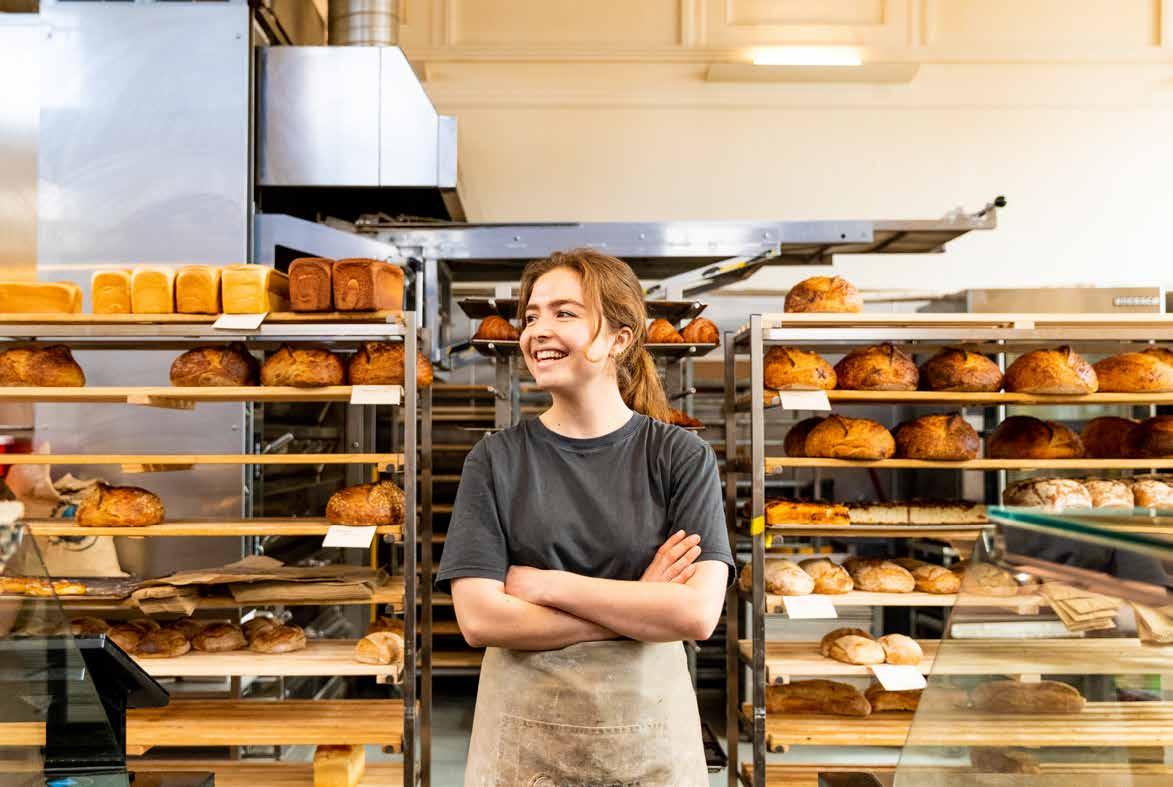
“There’s definitely some alchemy involved. If I have a bad day, the bread comes out a little ugly. If I have a good day, it’s nice and strong — I’ve always felt that.”

There’s science at work too. “The whole process is regulated to keep the same pH level, the same wild yeast level and the same temperature — 18 degrees. Auckland is actually a great environment for sourdough baking because we’re surrounded by the sea, so the air is full of different types of wild yeast.
“The key to a great sourdough is to give it time. With the sourdough we’re making today, we mixed the starter yesterday and now it’ll sit in the fridge for two days. We’ll let the lactobacillus do its thing, eat the sugars and break down the gluten structure, which makes it really digestible.”
Rhys has work to do and so we leave him to his kneading and grab five minutes with Pt Chev’s store manager, Emily Hancock. She’s been here pretty much from the start. “I was studying dancing at Unitec and came in one day looking for work and basically never left.”
Such was the allure — and delicious doughy aroma — of Daily Bread’s ovens. Though Emily admits a weakness for Daily Bread’s hazelnut pain au chocolat, she’s essentially a traditionalist. “You can’t beat the pioneer sourdough with a bit of avo, salt and pepper,” she says. “Maybe pickled onion if I’m being fancy.”
She’s proud that her bakery, with its covered outdoor café, has become Pt Chev’s destination du jour. “It’s a place where people
can sit down and have a chat with someone they don’t know. I love that. It’s a very inclusive place — for everybody, every day.”
Special mention — nay, a Nobel Prize for Yum! – goes to Little French’s majestic mushroom truffle mozzarella pie.
A firm favourite in The Point for a croissant and coffee on the run is the Little French Café. We’re served by Helena Broughton Rickard, a splendidly insouciant GenZer who squeezes in some barista work alongside modelling and uni.
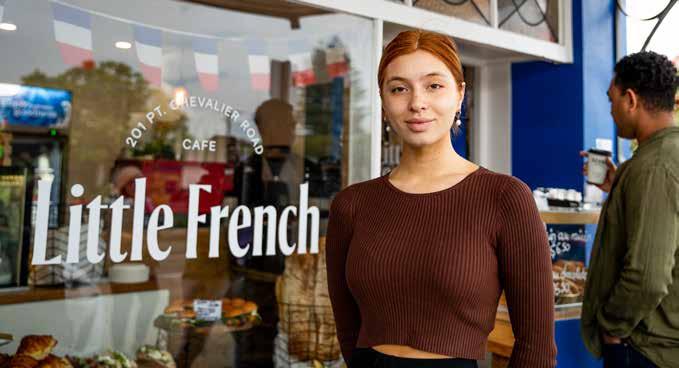
Her coffees are excellent, but the pastries here are from another planet.
And Helena’s favourite? “Honestly they’re all too good… they’re dangerous! Though I do have a soft spot for the custard pain au raisins.”
You may think it’d be nigh impossible to work here and stay in tip-top modelling shape. Not so, says Helena. “I love walking at Meola Reef and Western Springs. That’s where I like to go for ‘Hot Girl Walks’.”
Pardon?!
“Hot Girl Walks — that’s what they’re called these days.” Further research on the interweb reveals all: the ‘Hot Girl Walk’ is evidently a TikTok phenomenon where you take a 6.4km walk as you listen to a podcast or motivational playlist. But here’s the crucial detail: while you’re walking, your brain is only allowed to think about what you’re grateful for, your goals and… how hot you are.
So there you have it — now back to the pastries and coffee. Helena informs us that the most popular order would be an almond croissant with a trim flat white, extra hot on the side. We wonder: does everyone have their own custom-coffee kink these days?
“It’s a growing trend,” Helena affirms, “especially with the move to plant-based milks. We certainly get some unusual requests like flat whites with no foam, extra-hot flat whites with burnt milk, and extra-fluffy cappucinos, like for a baby. I’ve heard most things now.”
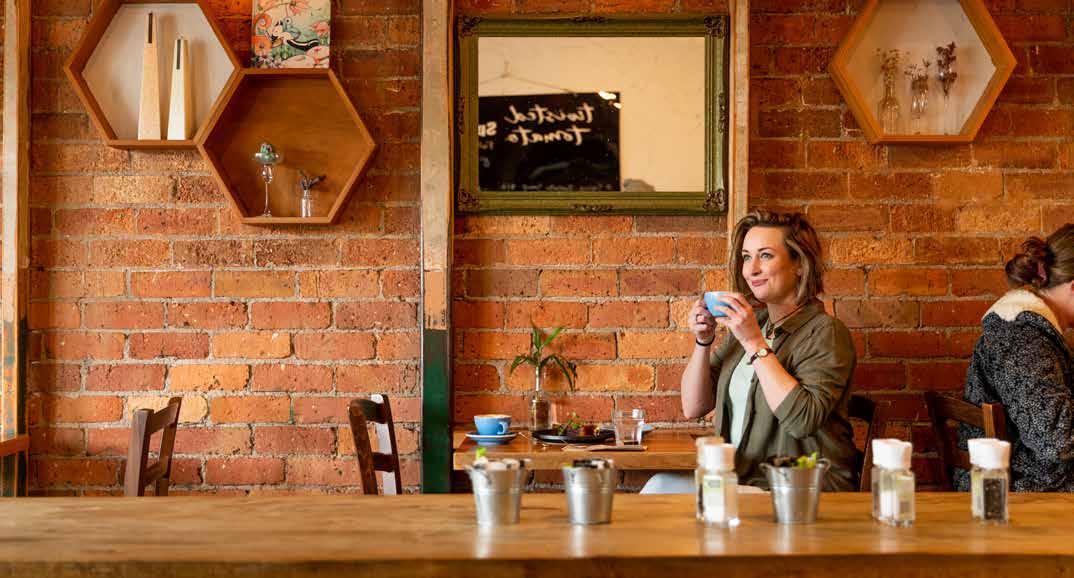
TWISTED TOMATO Cameron Wong never stops. He talks quickly, eyes dancing, hands never still, his mind on a hundred things. Starting mid-afternoon, seven days a week, he works long into the night at the auto-electrical business he’s had for 25 years. Then, by day with wife Bridget and 10-year-old daughter, Zoe he runs local institution, Twisted Tomato.
Yet somehow this man has time for everyone. He knows everything there is to know about his regulars names, kid’s names, birthdays, toast tips, egg runniness requirements and coffee quirks. Glancing around his café mid-morning, middle of the week, he gives us the rundown: “That’s Kate who has just walked in: she always has eggs bene with salmon, wilted spinach and medium poached eggs with a single shot cappuccino.
“Over by the window? That’s John: he has a latte every single time. Scott, sitting over there by the door? He works just up the road. He comes in every day, often with his son they’re Big Breakfast and flat white guys.” They came in once, then pretty much never left which Cameron says is typical 80% of their customers are regulars.
As we tuck into one of his world-famous-on-the-strip date and caramel scones, Cameron gives us a brief history of his hospitality. “My dad came to New Zealand as a refugee from Vietnam in 1979. We followed him over in 1981 when I was two.
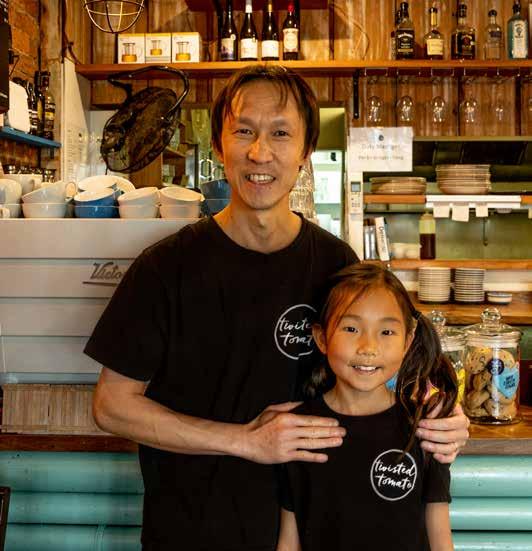
“Dad got a job here as a sheet metal engineer, but he always wanted his own business. When I was 12, Dad started up a bakery in Pakuranga and he basically never looked back.”
Mr Wong’s success wasn’t initially enjoyed by his son. “I had to get up really early each morning to help out. Every weekend, every school holidays… I hated it! But there was no choice really as with most Asian families it was an expectation.”
But he would later appreciate his years of hard labour. “Looking back, it gave me a great set of skills and a passion for baking. By the time I was 14, I knew how to bake the whole range, from Louise slices to chocolate eclairs; from breads to quiches to pies. It was a training ground for all the baking I do now in the cafe.”
You see, history repeats. “I've always wanted to own a nice cafe, not overly huge, but just something like this something with warmth, with character… somewhere that’s a little hub for the community.”
It's a generous vision, one he says that goes both ways. “It’s been pretty tough through Covid, of course, but our customers had our back. I remember the night we were going into lockdown and we’d made all our food. I put the message out on our Facebook page: ‘Hey guys. We’re having to close down blah blah… does anybody want anything?’ And within 20 minutes, all my cabinets were empty. All my regulars came through and just bought everything. Cleared me out. They’re just golden.”
AMBLER There’s a bit of a French theme going on along Pt Chev Road and Matthieu Gosset is a very charming part of it. This Parisian straight out of Central Casting opened Ambler in 2018. And he raised his two young girls on Harbour View Road just around the corner in what is, he contends, the best little neighbourhood in the Southern Hemisphere.
“You feel so removed from the city,” Matthieu says, “but then you are so close. The beach at high tide is unbeatable. And there’s such a nice, chilled vibe people are just so friendly around here.”
It’s perfect café territory really. “As soon as I saw the ‘For Lease’ sign go up in this building, I knew I had to have it!” he says. “I signed up within two hours. I always wanted this to be the focal point of Pt Chev somewhere people can come any time of the day. And so we serve breakfast, lunch and dinner six days a week.”
Bringing a bistro to the neighbourhood was a bold move, but Matthieu had an impressive gastronomic CV behind him: he opened the first of his La Boulange bakeries in 2010, followed by Petit Bocal in Sandringham, then Woodworks in Avondale. Besides Ambler, his current stable includes Wander in Wynyard Quarter and Atelier in K’ Road. It’s arguably the greatest French empire since Napoleon.
But there’s something extra-special about Ambler, something reflected in the very ordinariness of its name. “I wanted something a little bit to do with the area,” Matthieu says. “The idea was to have people just strolling or ambling around Pt Chev and stopping in for a coffee or a glass of wine.”
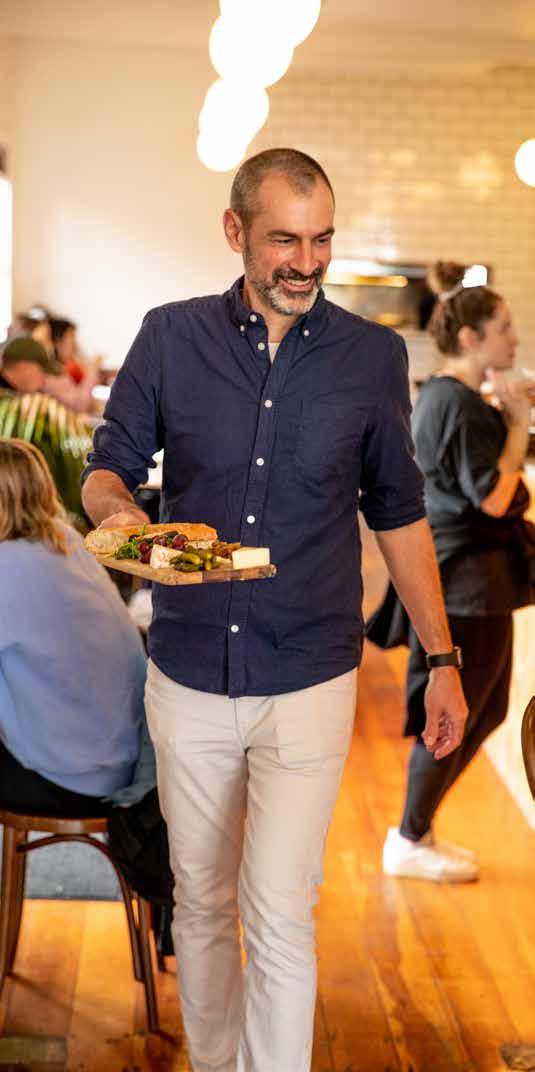
Or an understated banquet. So what does Matthieu recommend from the menu? “You can’t go past the iconic French dishes like croque monsieur, steak frites or œuf à la coque (a form of culinary wizardry involving boiled eggs, cured salmon gravlax, crème fraîche and polenta soldiers). But we also do Kiwi classics: our clams fettucine is rather fabulous.”
Then there are Ambler’s ‘Raclette Nights’ which Matthieu organises every month or so. “It’s a Savoyard dish,” he explains, where you have a special cheese you melt on a cooker, then scrape off with boiled potatoes and charcuterie. It’s divine.”
These are epic evenings. “You get tables of 25 French people being loud and rowdy,” he says. “But you don’t have to be French to come." You just need a French attitude evidently a fondness for fine food, finer wine and impassioned discussions that may go on for some time.
PT CHEV BEACH CAF É A self-described swim junkie with a chlorine allergy, Karim Rostami spent two hours in the pool this morning where he cranked out 6km 120 lengths on top of the 24km he’s already swum this week. He’s tired, snuffly but afire with stories he loves to share with customers at Pt Chev Beach Café, the buzzing hub he’s run for the past six years.
They're great yarns unbelievable, irresistible, and terrifically tangential Sticking with Karim’s great passion for swimming, opting for the discipline of the pool, seems an orderly way ahead.

Except Karim only started swimming in 2015. “I randomly decided to challenge myself and learn how to swim,” he says. “My swimming background was zero, nothing. And the challenge is that, technically, I’m a disabled person. I’m a survivor of polio. When I swim, I can’t use my legs at all. I have a band that ties my ankles together: I use my upper body only.”
And this is where the story, in Karim’s own words, gets a little crazy. Because he was not content with merely learning to swim, of finding a way to stay afloat and haul his withered limbs from one end of the pool to the next. Instead, he heads to the open water: he swims from Takapuna to St Heliers, joins a relay from Waiheke to Auckland and then, last year, swims from Great Barrier Island to the city, part of a team that includes ex-All Black Ian Jones and former world triathlon champ, Rick Wells. This epic 100km swim took more than 24 hours.
There’s more. In 2019, Karim completed the Taupō Ironman 70.3. After his swim, he rode 90km on a specially modified bike with hooks that held his feet in, and then, on tiny, flapping legs, he ran 21km. He was last home. Put Karim’s name into YouTube and the footage from Taupō will make you cry.

He raised $46,000 that day for the UN’s Polio Eradication Programme. He’s raised tens of thousands more for Surf Lifesaving New Zealand and the Westpac Rescue Helicopter Trust. The Great Barrier swim raised $400,000 for St John which bought two ambulances.
“I want to give back to this country,” he says. “I was 18 years old when I arrived here. A refugee from Afghanistan running from the Taliban. I couldn’t speak English. I had no family, no friends. I had no home. I didn't have a dollar to my name. I had nothing. And I had polio.
“If this country didn’t give me a second opportunity to live here; if this country didn't accept me for who I was when I turned up at the airport with nothing 20 years ago, I wouldn’t be standing here in front of you now.
“For me to give back to this country, for this beautiful nation, for the people… I don’t think I'll ever in my lifetime be able to give back what has been done for me.”
The regulars at Pt Chev Beach Café would quibble ferociously with this last point. This café, formed around the effervescence of its owner, has become a local institution (shortest review: Heavenly kai, supreme coffee and seriously addictive Little Lato gelato). Karim, this “proud, second-hand Kiwi”, is an Aotearoa legend.
BAR MARTIN Bar Martin is one of those hidden gems that the better part of you yearns to trumpet to the world and evangelise to all who would listen but your ignoble, selfinterested side wants to keep secret and all to yourself. Tucked away in a quiet residential backwater, just in behind Baldwin Avenue station in Mt Albert, it is the ultimate local’s local. We dropped by at 4pm on a Wednesday afternoon thinking we’d be the only customers, but instead found the place packed to the gunnels. An eclectic horde of young hipsters, funky families and mature gents in peaked caps (along with an over-enthusiastic husky) ensured it was standing-room only.
Owner Ruben Maurice was going to share the secrets of his success with us, but was way too busy with wine tastings, rustling up food and generally leading from the front. Never mind we can report his wine list is lovingly curated and the food hearty; the potato gratin with truffle cream was demolished by our hungry crew.
The exacting Sir Jesse Mulligan had been as flummoxed as we were when he stepped inside Bar Martin earlier this year: “Not quite Mt Albert, not quite Western Springs, this little residential pocket may as well have been in Narnia for all I recognised about my surroundings.” But Sir Jesse was seduced just as swiftly.

“The bar is perfectly, stylishly lit,” he wrote, “with plenty of seats inside and out, and a dog and a cat who may or may not have been getting paid to be there.
“There’s little in life more comforting than enjoying a lovely drink, with good company and snacks, and something furry to rest your foot on. Plug this address into your phone and see where the evening takes you.”

All of us have a sliver of Aotearoa we consider ‘ours’. It’s not our home, never our work, but rather that unremarkable park around the corner, that beach walk, that bit of bush that becomes your own. It’s often connected to our childhood: here is where you built your forts, nīkau fronds heaped upon mānuka bones, made secret tracks marked with toetoe flags, and commanded armies against enemies so furtive you never saw them.
For the future residents of Toi, Te Auaunga is destined to become your ‘local’ — your sanctuary, your own secret corner of the world. It’s a wondrous place, a tangle of old man pines, harakeke and tī kōuka; of marshes, great mossy boulders and a cantankerous creek; of a churning 6m high waterfall that calms all under its spell.
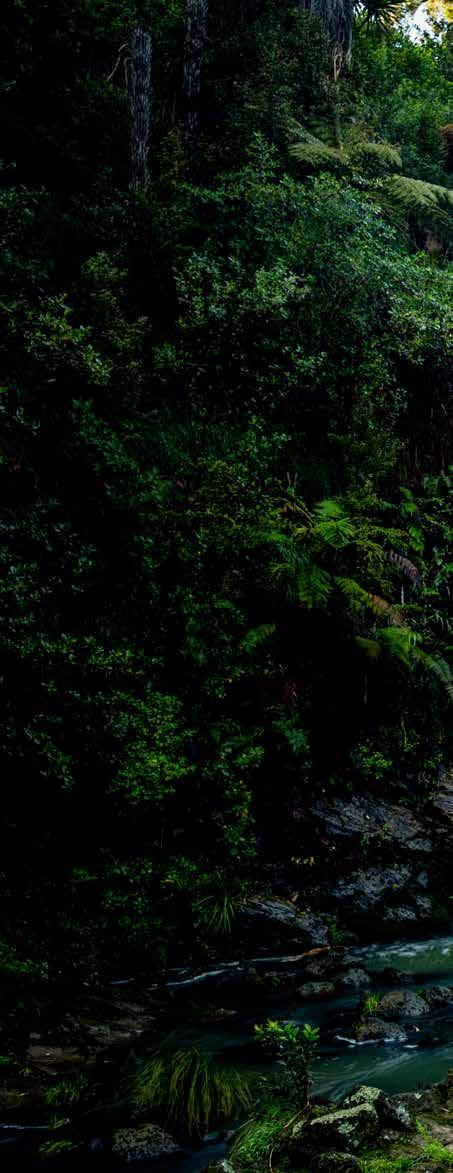
One of the finest New Zealand essays in recent decades was dedicated to this place. In 2010, Kennedy Warne, the founding editor of New Zealand Geographic , visited the creek each day for six months, from the shortest day of the year to the longest. ‘Pilgrim at Oakley Creek’ was the result.
“It has become the place I go to be enfolded into nature and woven into the world,” Warne wrote. “It is where I lose myself, and where I find myself.”
There are three walkways in off Great North Road. You need only descend six or seven stairs for the hubbub of the city to fade and for tui and fantails — pīwakawaka — to take over. The transition to tranquility is almost instant. “The city, saturated in its human agendas, can tilt us dangerously out of plumb,” writes Warne. “The natural world, with its seasons and rhythms, the ancient order of things, restores the soul’s even keel.”
This was ‘his’ place. “There was a feeling of shared membership in an exclusive club,” he continued, “a feeling enhanced by the fact that the reserve is somewhat hidden from view, in a deep valley beneath Great North Road. Many times I have looked up at the rush-hour traffic creeping home to the western suburbs and thought, ‘You have no idea what’s down here, do you?’”
“Where can the city dweller look for the inexhaustible wild? Perhaps it lies closer than we think, on the flipside of the ordinary, along the unkempt edges of the familiar. An urban green space can become a site of pilgrimage, a place to discover a waterfall by moonlight…”
KENNEDY WARNE, PILGRIM AT OAKLEY CREEK

WESTERN SPRINGS “This is a large popular central park with a lake in the middle,” Auckland Council’s website says of Western Springs. A masterpiece in restrained prose (or perhaps the work of a disenchanted copywriter late on a Friday afternoon), the description barely hints at the wonders that lie within this 15-hectare wildlife sanctuary.
For the Peoples’ Park, a sprawling tapestry of great lawns, bush walks and birdlife just 1km from Toi and less than 4km from the CBD, is one of Auckland’s gems. Stroll around the 1.75km path that circles the lake, then loop round for a second lap.

You will be joined by the Tāmaki Makaurau whānau — stumbling toddlers failing to catch ducks, timorous teenagers holding hands; mums in activewear, texting dads and that nice older couple having a picnic under a pōhutukawa.
Western Springs will give you succour whatever your mood. You can while away hours staring at the trees stunningly mirrored on the water, or spying eels, or simply having a lateafternoon snooze (your backing soundtrack: frazzled mama ducks, occasionally insistent swans and, every now and then, roaring lions from the zoo next door).
Down the west end of Western Springs, don’t miss the Fukuoka Garden, a gift to Auckland from our Japanese sister city. Entry is free: there’s a tea pavilion, waterfall and pond; the garden, itself, is made up of more than 1800 species of Japanese and Aotearoa plants.
MOTAT The Museum of Transport and Technology has more than 300,000 objects in its collection including trams, trains, trucks and trolleybuses, a rocket, one of Ed Hillary’s Massey Fergusons, and more planes than the Royal New Zealand Air Force.
The Pioneers of Aviation Pavilion includes relics from Richard Pearse’s first plane, the one that beat the Wright Brothers into the air by several months. Meanwhile, get your Top Gun fix by inspecting the MOTAT 2 collection which include a flotilla of flying boats, a Grumman Avenger torpedo bomber, P40 Warhawk, a De Havilland Mosquito, Lancaster bomber, a Vampire and a Skyhawk.
But that’s not all: make your way to the north side of the great park and you’ll find Western Springs Stadium, the city’s natural amphitheatre. The most legendary concerts in our history have taken place here — think Bowie, Led Zep, The Stones, Bob Marley, The Boss and Six60 – and it’s also host to epic speedway action 12 Saturdays a year.
AUCKLAND ZOO
With 1,400 animals from 135 species living in tranquil park-like surrounds of 16 hectares, Auckland Zoo is unrecognisable from the days of chimp tea parties and elephant rides. Now organised by region of origin, the zoo includes an African Safari Trail (with giraffes, zebras, rhinos, lions and cheetahs), a South America Rainforest Track (starring impossibly cute tamarins), Te Wao Nui (the native flora and fauna of Aotearoa), and a South East Asia Jungle track (with self-effacing Sumatran tigers, and orangutans who clamber along aerial pathways 25 metres above you).
Later this year, the zoo celebrates its centenary. In the hundred years since, Auckland’s population has increased from 85,000 to 1.7 million; the global population has jumped from 1.9 billion humans to nearly 8 billion. Correspondingly, the number of wild animals in the world has fallen by more than two-thirds over the past 50 years. It can seem a bleak picture. However, the evolution of Auckland Zoo into a leading wildlife conservation science centre, one that reconnects an ever-more-urbanised population with the natural world, is a small, hopeful step.
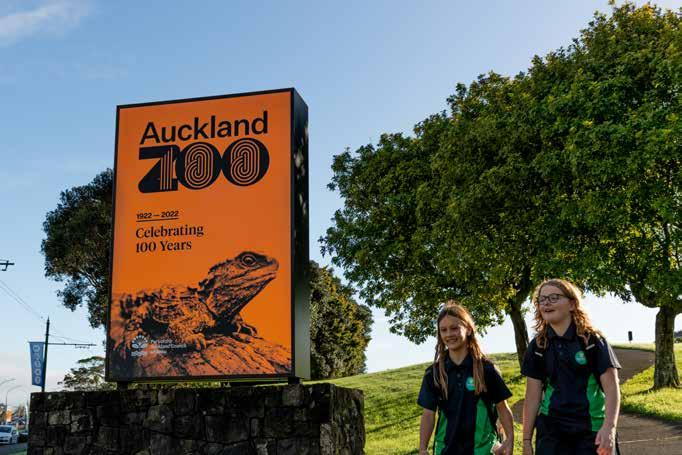
CHAMBERLAIN PARK GOLF COURSE “Foooooooooore!” This 34-hectare public course brings golf to the masses. It’s the busiest 18 holes in the country — over 70,000 rounds were played in 2020 — and it’s inarguably the most, er, ‘democratic’ (the number of shanks, slices and mulligans are uncountable). With $20 rounds after 3pm, this is the perfect way to while away a summer afternoon, get your 10,000 steps in — and Tigerishly tear through the course in under a hundred.
PT CHEV BEACH

It’s one of Auckland’s finest, calmest and loveliest family beaches. Tucked in behind Coyle Park Peninsula, this 400m sandy strip is perfect for summer cool-offs, paddling with the kids, and watching kitesurfers reach unimaginable speeds. After a hard afternoon’s lazing in the sun, you’ll have earned yourself a gelato — two scoops, thanks — from Pt Chev Beach Café.
MEOLA REEF DOG PARK
Yet another wee wilderness within walking distance of Toi, Meola Reef is also central Auckland’s only fully fenced, year-round, off-leash dog park where great fleets of Fidos roam about looking for pats. Set amongst a 15-hectare reserve that looks out over a mangrove forest, Meola Reef takes in great views of the upper Waitematā and across to the Chelsea Sugar Refinery. But that’s not really why you’re here: “There is a bushy area for dogs who like to snuffle through leaf litter, long grass areas for chasing and springing about, and mown areas for high speed antics.”
Toi will be the eighth development in the MarutūāhuOckham partnership. It has been a wonderful journey thus far and we like to think our work together reflects that.
We have finished two developments, Tuatahi and the awardwinning Kōkihi, with two more — Aroha and Manaaki — nearing completion. We have four more projects in the planning and consents phase, including Manawa in Avondale, a second epochal, city-shaping project alongside Maungārongo.
The reason we reel off our ‘greatest hits’ is not to wallow in old glories — well, not for more than a moment — but because a developer’s track record is everything. We know buying off the plans is a leap of faith and we’re extremely appreciative of your trust in us. We invite you to do your ‘due diligence’ and see what we’ve built, what we’re building — and what we have in the pipeline.
The name, Tuatahi, simply means “The First”. Completed in November 2019, this 119-apartment development in Mt Albert marked the start of the Marutūāhu | Ockham partnership.
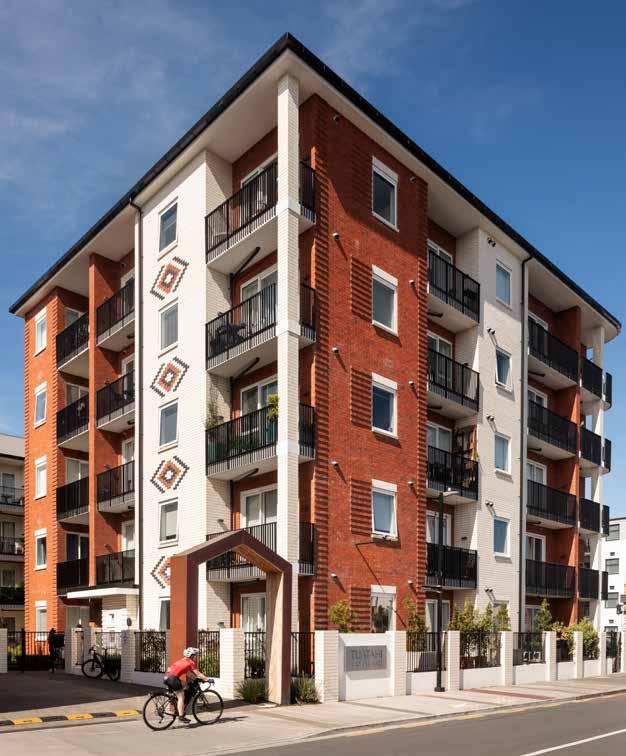
The brief was for something brilliant — something distinctive, something memorable — and one of the city’s great buildings would provide inspiration. This was Hotunui, the iconic wharenui of Ngāti Maru that was loaned to the people of Tāmaki Makaurau almost a hundred years ago and continues to live in the Auckland Museum. It is the most visited wharenui in the world.
A stunning meeting house, Hotunui is intricately detailed yet layered with restraint. The exterior brickwork at Tuatahi references the Hotunui tukutuku panels, while the new building’s pitched roof also invites comparison with the structural composition of wharenui. At both entrances to Tuatahi, striking copper and wood waharoa (gateways) further the sense that when one steps inside they are arriving somewhere special.
The three buildings at Tuatahi are enhanced by a lush lawn and landscaped garden that spill from the residents’ lounge — this is a place where everyone can pass time together. There’s also something upstairs at Tuatahi that makes it unique: a library and collective space that exudes zen, thought and quiet contemplation.
The second chapter of the Marutūāhu | Ockham story, Kōkihi in Waterview consists of 95 apartments, including 47 KiwiBuilds.

Kōkihi — meaning that moment where we see emerging green, new growth, the promise of tomorrow — signifies the emerging partnership that has gone on to shape the landscape of Tāmaki.
As with Tuatahi, Kōkihi pays homage to Hotunui, the famed wharenui at Auckland War Memorial Museum. With tukutuku patterns ingeniously woven into its brickwork, Kōkihi references motifs found inside the wharenui including (stars) and toa (warriors). Precast patterned concrete panels reflect light and shadow according to the weather and time of day. Kōkihi is a building steeped in the mood of Tāmaki, with another magnificent copper waharoa set at the pedestrian
entrance, carved with patterns referring to Kaiwaka, the star of the iwi that heralds the beginning of the lunar month of Kohitātea (January) or Hakihea (December).
Then there are three pou — Tauihu, Te Korowai o Te Aroha and Tirohanga Mātārae. Carved by Tohunga Whakairo Michael Matchitt, the pou embody the kaupapa that guides the partnership behind Kōkihi — community, whānau, and whenua.”
Housing Minister Megan Woods opened Kōkihi in July 2021. “Marutūāhu | Ockham have built 95 new homes on land where seven houses once stood,” she said. “And that is a number I think we need to stop and consider. We’ve created 95 new places where dreams can be fulfilled, and children can grow up, and people can make their lives.”
And it’s not just us that think that Marutūāhu | Ockham are pretty special— Kōkihi won a multi-unit building award at the 2022 Property Council Awards.
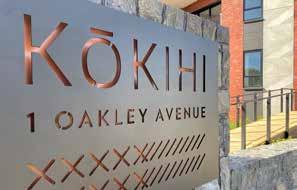
“A developer’s track record is everything. We know buying off the plans is a leap of faith and we’re extremely appreciative of your trust in us. We invite you to do your ‘due diligence’ and see what we’ve built, what we’re building — and what we have in the pipeline...”
MARK TODD, OCKHAM
Aroha, the third instalment in the Marutūāhu | Ockham partnership, brings 117 apartments (including 47 KiwiBuilds) to up-and-coming Avondale. It’s a dynamic community — one of the best — where people work hard, look forward to the future, look out for each other too.
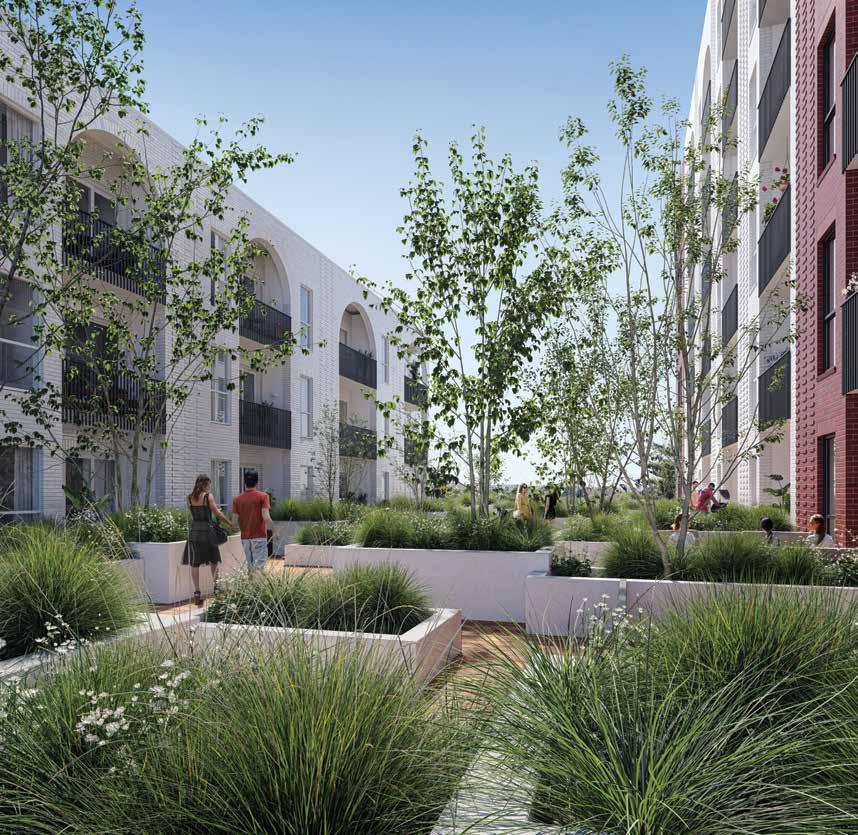
Set at the intersection of Great North Road and Ash Street, Aroha will be an entrance, a sort of gateway into Avondale, and so our designers knew they needed something timeless. They were drawn to the arch. From the Colosseum to St Peter’s to the Arch of Constantine; from the Taj Mahal to the Blue Mosque, arches have been an enduring element of engineering and architecture.
If an arch ushers you inside, it also emphasises the verticality of the building. The arches of Aroha draw the eye up to the sky. The exterior bricks also take on their surroundings — a white glazed brick flexes and mirrors the day, reflecting the blues on a sunny day, the greys when overcast. These are set aside bricks of dappled red with subtle mauve hues which add a warm and distinctly residential look to Aroha.
Aroha — the name translates to ‘love, compassion, empathy’ — is fully pre-sold and scheduled for completion in early 2023.
Set beside a secret park , bordered by a no-exit cul-de-sac, Manaaki is 400m from Onehunga Mall, the wonderful (and wonderfully random) main street that centres Auckland’s most characterful suburb. With the unmistakable grandeur that comes with being one of the city’s oldest neighbourhoods, leavened with a little light industrial grit, Onehunga has it all.
Numbering 210 apartments — including 87 Kiwibuild units — Manaaki has taken our commitment to community to new heights.

There’s a pool, subtropical gardens, a ranch-sized residents’ lounge and an in-house cafe where you can caffeinate like a boss. And there’s something else, something new: we’ve added four work-from-home spaces where our residents can enjoy the camaraderie of the office without the commute (perhaps even in their PJs… or perhaps not).
The fourth partnership in the Marutūāhu | Ockham story, Manaaki represents another beautiful concept in te reo rangatira and Te Ao Māori. It means ‘to support, to take care of, to show respect, generosity and concern for others’. It’s a fine principle to live by, and fitting ideal for us to work towards.
Under construction and already 80% sold, Manaaki will be finished in Q3 2023.
We have a track record of building homes well-loved by those who live in them. We’ve completed 14 projects to date, 746 homes across Tāmaki Makaurau, and won awards and plaudits along the way. Currently we have another five projects numbering 487 apartments under construction and slated for completion in 2023.
Herewith eight of our buildings from the back catalogue: we encourage you to whizz around town on a sunny Sunday afternoon and check them out for yourself.
Opposite Eden Park — and just 100 metres from Kingsland Train Station — the eponymous Ockham building was our first development, completed in 2011. It was lauded in Auckland City’s Design Manual as an exemplar of a low-rise apartment building within a character area, with excellent building design and sizeable, sun-drenched communal courtyard.
11
Facing the Mt Eden train station, this sleek project sits amid the buzz and bustle of one of inner-city Auckland’s coolest neighbourhoods. It features Ockham’s signature top-floor residents’ lounge and deck, so that everyone who lives in its 37 apartments can enjoy the north-west vista and some sun. Station R was shortlisted for Home magazine’s 2018 Home of the Year.
11
Centred around a private lane, The Isaac’s 75 apartments sit within three buildings, each with their own residents’ lounge and large rooftop terrace, offering glorious 360° views across the city. This stately development also featured in the Auckland Design Manual (“Ockham has succeeded in not only creating a collection of buildings but, more importantly, in creating a place.”).
Daisy expresses core Ockham ideals — elegance, sustainability, community. Winner of an Excellence Award at the 2019 Property Industry Awards, Daisy’s suite of eco-initiatives and green technologies saw it earn a 10 Homestar rating, still the highest of any apartment building in New Zealand. This 33-unit carparkless development comes with scooter parks and a communal EV Cityhop car.
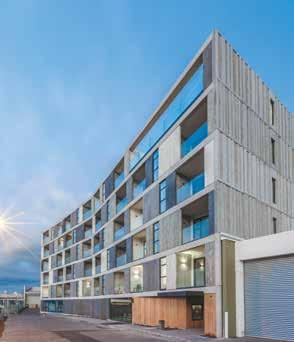
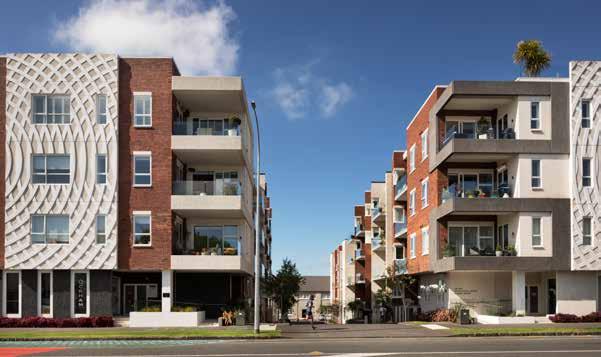
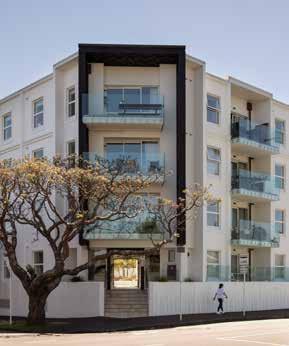

246 Khyber Pass Road, Newmarket
Situated a block from Auckland Domain — and perched directly above Grafton Train Station — Hypatia vividly demonstrates the connectivity and convenience of innercity living. Featuring a 20m indoor pool and jacuzzi, Hypatia is best-known for the stunning Māori patterning on the precast concrete panelling — the work of Ngāi Tai Ki Tāmaki kaiwhakairo (head carver) Reuben Kirkwood.

2 Ariki Street, Grey Lynn
A striking, vividly white building that sits along the Great North Road ridgeline, The Turing’s impressive array of communal facilities include a residents’ lounge and terrace, full-sized billiards room and standalone gym. With the exterior patterning referencing Alan Turing’s work in mathematical biology, abstraction and precision meld together in perfect harmony.
81 Mapou Road, Hobsonville
The curves! The bricks! The gardens! Never has the Ockham ‘look’ been realised so thoughtfully as the 120-unit Bernoulli Gardens in Hobsonville. Longlisted for Home ’s 2019 Home of the Year, Bernoulli celebrates our commitment to classic brick — but also to community, specifically the sprawling residents’ lounge and grand village green which gives it its name.

845 New North Road, Mt Albert
A shimmering black brick building at the apex of Asquith Ave and New North Road, Modal was Ockham’s first ‘Build to Rent’ project. Just minutes from both the Baldwin Ave and the Mt Albert train stations, carparkless Modal was Highly Commended in the apartment or townhouse category at the 2021 Here Awards and then won the big one — Best Multi-Unit Building at the 2022 Property Council Awards.

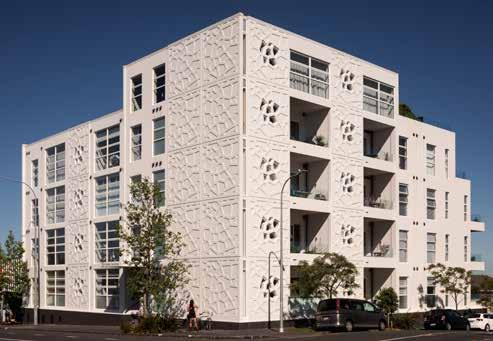
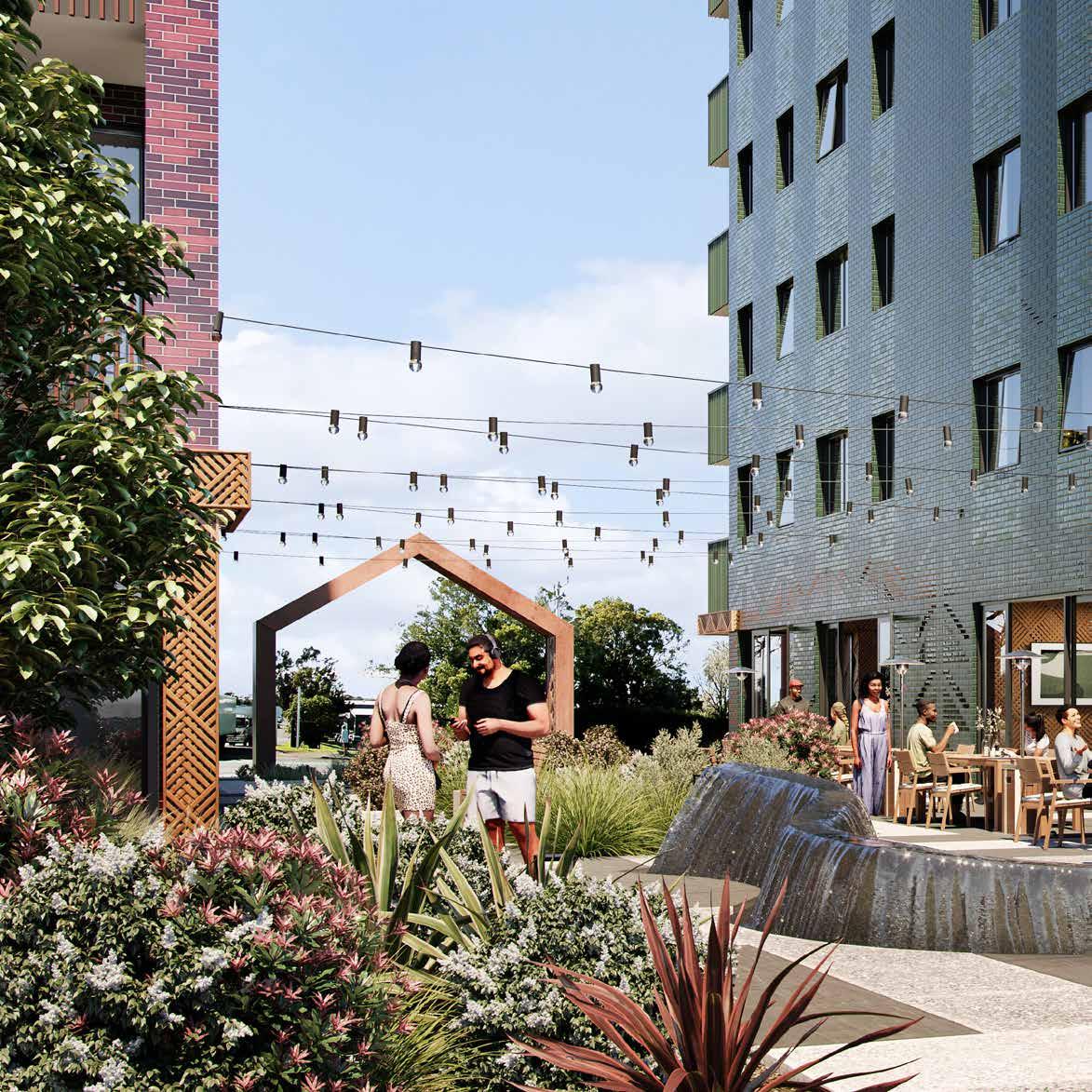

“A huge part of our story has been our deepening partnership with Marutūāhu Iwi,” says Ockham captain Mark Todd. “It began with Tuatahi in Mt Albert and was followed by the award-winning Kōkihi. We have two more projects under construction — Aroha and Manaaki — and when these are completed in 2023, we’ll have delivered 541 new homes in Tāmaki Makaurau, 199 of them KiwiBuilds.”
The partnership rests upon a joint moemoeā (vision) says Marutūāhu chair, Paul Majurey. “It was clear in my first hui with Mark that our values are very much aligned — a far-sighted approach, a deep connection to Tāmaki Makaurau and a recognition that community is at the heart of any good development.
“We share some very long-term aspirations around the built environment. We see housing as fundamental to people, a legacy we leave to future generations— and to Tāmaki Makaurau.”
For Ockham, barely a dozen years old, the guidance of an older mentor — a Tuakana with more than 30 generations’ experience — has been invaluable. It has sharpened the company’s focus: a commitment to community, to whānau, to whenua.
“It’s been a delightful journey,” Mark Todd says, reflecting on the Marutūāhu connection. “I have learnt so much more about belonging. My relationship with
The Marutūāhu Confederation consists of the iwi of Ngāti Maru, Ngāti Pāoa, Ngāti Tamaterā, Ngāti Whanaunga and Te Patukirikiri. We whakapapa to the celebrated eponymous tūpuna, Marutūāhu, son of Hotunui, whose ancestors came to Aotearoa on the Tainui waka.
Our rohe (customary tribal area) extends from Mahurangi in the north to Matakana in the south, including Tāmaki Makaurau, as acknowledged in the pepeha: “Mai Ngā Kuri a Whārei ki Mahurangi or mai Matakana ki Matakana.” We share this rohe with related tribes.
A precious taonga that we belong to is the wharenui, Hotunui, which lives in the Auckland Museum. Carved by Ngāti Awa and Ngāti Maru Tohunga Whakairo (master carvers) in 1878, the house celebrated the hononga (union) between Ngāti Maru and Ngāti Awa, including the marriage of Mereana Mokomoko of Ngāti Awa and Wīrope Hōtereni Taipari of Ngāti Maru. It’s a stunning example of 19th-century craftsmanship that we’re delighted to share with the people of Tāmaki Makaurau.
“With Maungārongo, we’re building a village within a city. It’s a very special project — creating a high-quality, colourful, extremely desirable community that will honour our beautiful city.”
We strive to make thoughtful , distinctively residential buildings inspired by the landscapes of Aotearoa. We believe housing is essential infrastructure — the building blocks of community — and our built environment belongs to us all.
With our partners, Marutūāhu, we are reimagining urban communities. Our shared ambition is to make beautiful buildings that people love to live in, homes that honour this dynamic Pacific city, stand the test of time, inspire others — and bring a fantastic lifestyle to as many people and communities as we can.
Contributing to the extended Aotearoa whānau is also important to us. We are lead sponsor of Objectspace, Auckland City FC and the Ockham New Zealand Book Awards; we also fund the Ockham Collective, One Tree Hill 1st XV and the Bridget Williams Books’ Texts Collection (among other initiatives). In heart and mind we support Aotearoa creativity and critical thought.
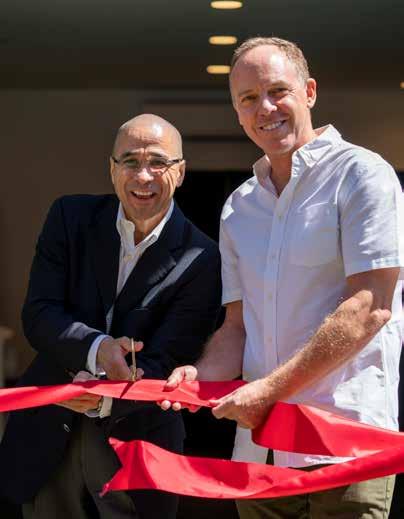
The bossy legal stuff: Photography and renders are for illustration purposes only. Original photography by Ockham except where noted: Page 13: The photograph of Hotunui was taken by Derrick Coetzee, phormium tenax by Simona/stock.adobe.com.
Thank you to Geoff Budd (pages 11, 42), The Hood & Co (pages 24-31, 33, 43), Keri Little (page 23), Kallan Macleod (pages 35 left image, 38 Station R) and Patrick Reynolds (pages 34, 38-39 except as noted).
For more information, and more pics, visit our website: ockham.co.nz/toi
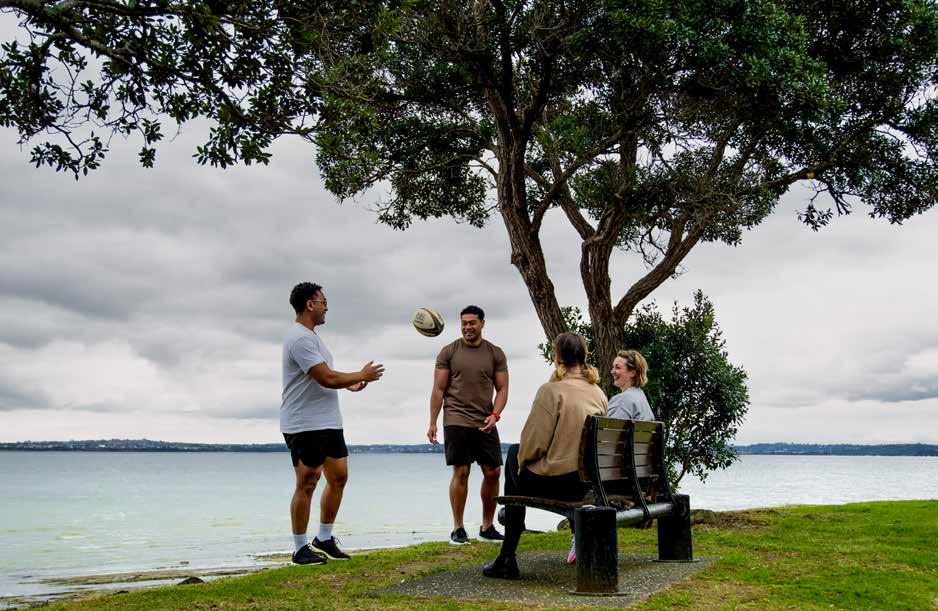
Marutūāhu and Ockham express their gratitude to the good citizens of Pt Chevalier for sharing their stories with us. Special thanks to Matthieu Gosset (Ambler), Ruben Maurice (Bar Martin), Emily Hancock and Rhys Harvey (Daily Bread), Helena Broughton Rickard (Little French Café), Karim Rostami and Ruth Robertson (Pt Chev Beach Café), Cameron, Bridget and Zoe Wong (Twisted Tomato). And a hearty tēnā koutou to The Hood & Co whānau.
Disclaimer: While we’ve taken every effort to ensure the accuracy of the information found in this document, Ockham Residential Realty Ltd cannot take any responsibility for any errors or omissions. Purchasers are advised to complete their own due diligence on the subject property
Ockham Residential is Principal Sponsor of and a sponsor of
For more information, please contact:
Joss Lewis
Phone: 021 245 5155
Email: joss@ockham.co.nz
Zara Kehoe
Phone: 021 162 4451
Email: zara@ockham.co.nz
Lisa Redgrove
Phone: 021 415 980
Email: lisa@ockham.co.nz
OCKHAM.co . nz